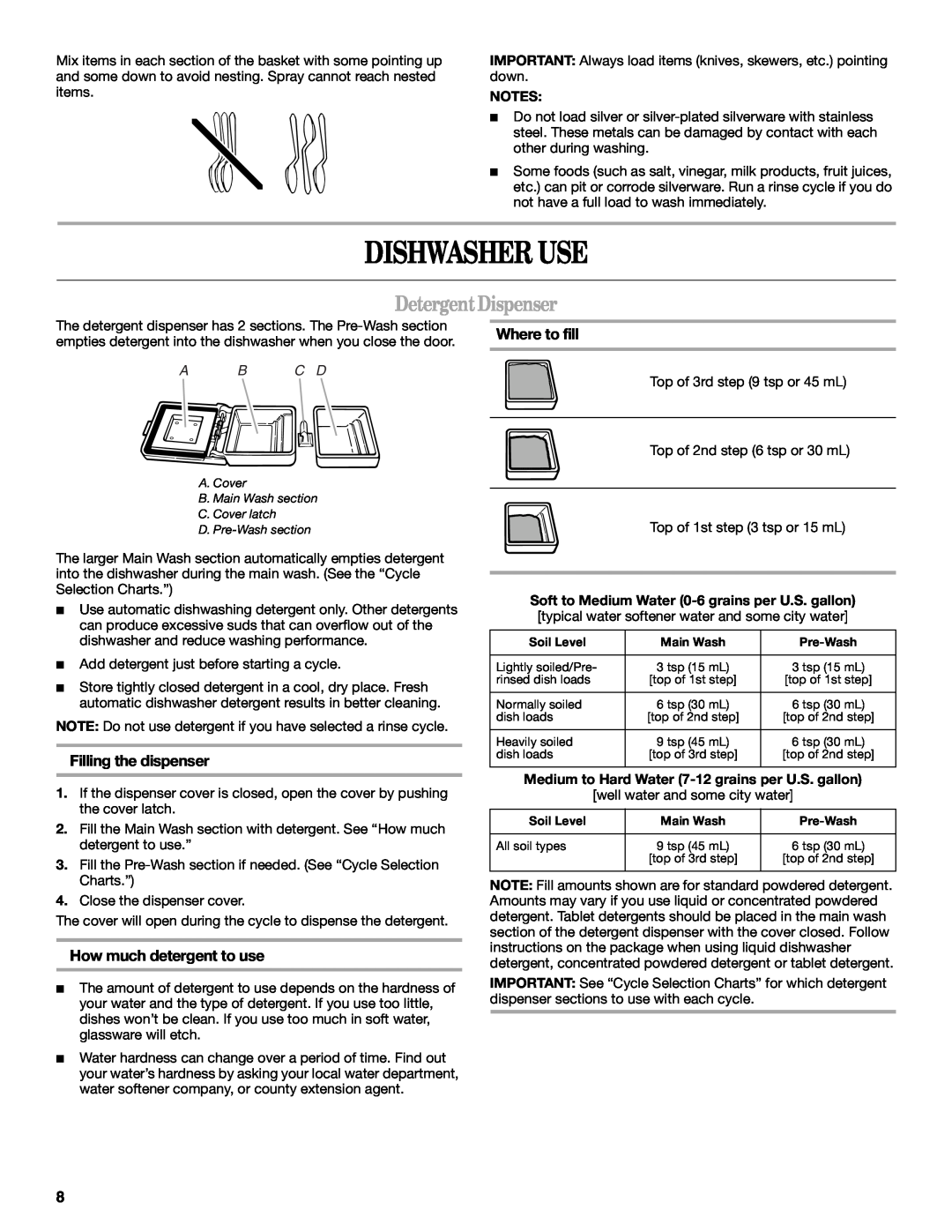
Mix items in each section of the basket with some pointing up and some down to avoid nesting. Spray cannot reach nested items.
IMPORTANT: Always load items (knives, skewers, etc.) pointing down.
NOTES:
■Do not load silver or
■Some foods (such as salt, vinegar, milk products, fruit juices, etc.) can pit or corrode silverware. Run a rinse cycle if you do not have a full load to wash immediately.
DISHWASHER USE
Detergent Dispenser
The detergent dispenser has 2 sections. The
A B C D
A.Cover
B.Main Wash section
C.Cover latch
D.
The larger Main Wash section automatically empties detergent into the dishwasher during the main wash. (See the “Cycle Selection Charts.”)
■Use automatic dishwashing detergent only. Other detergents can produce excessive suds that can overflow out of the dishwasher and reduce washing performance.
■Add detergent just before starting a cycle.
■Store tightly closed detergent in a cool, dry place. Fresh automatic dishwasher detergent results in better cleaning.
NOTE: Do not use detergent if you have selected a rinse cycle.
Filling the dispenser
1.If the dispenser cover is closed, open the cover by pushing the cover latch.
2.Fill the Main Wash section with detergent. See “How much detergent to use.”
3.Fill the
4.Close the dispenser cover.
The cover will open during the cycle to dispense the detergent.
How much detergent to use
■The amount of detergent to use depends on the hardness of your water and the type of detergent. If you use too little, dishes won’t be clean. If you use too much in soft water, glassware will etch.
■Water hardness can change over a period of time. Find out your water’s hardness by asking your local water department, water softener company, or county extension agent.
Where to fill
Top of 3rd step (9 tsp or 45 mL)
Top of 2nd step (6 tsp or 30 mL)
Top of 1st step (3 tsp or 15 mL)
Soft to Medium Water
[typical water softener water and some city water]
Soil Level | Main Wash | |
|
|
|
Lightly soiled/Pre- | 3 tsp (15 mL) | 3 tsp (15 mL) |
rinsed dish loads | [top of 1st step] | [top of 1st step] |
|
|
|
Normally soiled | 6 tsp (30 mL) | 6 tsp (30 mL) |
dish loads | [top of 2nd step] | [top of 2nd step] |
|
|
|
Heavily soiled | 9 tsp (45 mL) | 6 tsp (30 mL) |
dish loads | [top of 3rd step] | [top of 2nd step] |
|
|
|
Medium to Hard Water
[well water and some city water]
Soil Level | Main Wash | |
|
|
|
All soil types | 9 tsp (45 mL) | 6 tsp (30 mL) |
| [top of 3rd step] | [top of 2nd step] |
|
|
|
NOTE: Fill amounts shown are for standard powdered detergent. Amounts may vary if you use liquid or concentrated powdered detergent. Tablet detergents should be placed in the main wash section of the detergent dispenser with the cover closed. Follow instructions on the package when using liquid dishwasher detergent, concentrated powdered detergent or tablet detergent.
IMPORTANT: See “Cycle Selection Charts” for which detergent dispenser sections to use with each cycle.
8
